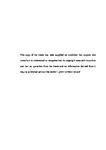LIFE CYCLE ASSESSMENT OF FLAX FIBRES
| dc.contributor.supervisor | Summerscales, John | |
| dc.contributor.author | Dissanayake, Nilmini PJ | |
| dc.contributor.other | Faculty of Science and Engineering | en_US |
| dc.date.accessioned | 2012-04-27T11:24:12Z | |
| dc.date.accessioned | 2011-06-13T10:45:37Z | |
| dc.date.available | 2012-04-27T11:24:12Z | |
| dc.date.available | 2011-06-13T10:45:37Z | |
| dc.date.issued | 2011 | |
| dc.date.issued | 2011 | |
| dc.identifier | 10093270 | |
| dc.identifier.uri | http://hdl.handle.net/10026.1/969 | |
| dc.description | Metadata merged with duplicate record (http://hdl.handle.net/10026.1/483) on 20.12.2016 by CS (TIS). | |
| dc.description | This is a digitised version of a thesis that was deposited in the University Library. If you are the author please contact PEARL Admin (pearladmin@plymouth.ac.uk) to discuss options. | |
| dc.description.abstract |
This thesis aims to investigate the sustainability of bast fibres specifically flax fibres as the reinforcement for polymer matrix composites (referenced to glass fibres) by undertaking a quantitative Life Cycle Assessment using the eight environmental impact classification factors of global warming, acidification, eutrophication, human toxicity, aquatic toxicity, ozone depletion, photochemical oxidants creation and non-renewable/abiotic resource depletion. A data set was compiled from numerous literature sources to complete the Life Cycle Inventory for the production of flax fibres. Three scenarios were studied for the production of either flax sliver (pre-spun fibre) or yarn (post-spun fibre): low (no-till combined with warm water retting), average (conservation tillage with stand/dew retting) and high (conventional tillage with bio-retting) energy routes considering different agricultural and fibre preparation (retting) methods. The best agricultural practice for the flax fibre production is identified from this study as the no-till method combined with warm water retting. The environmental credentials for flax fibre can be further improved by using organic fertilisers and biological control of pests. Spinning is the most energy intensive fibre processing operation hence by eliminating this operation energy use and the associated environmental impacts could be reduced. Based on the energy analysis continuous glass fibre reinforcement appears to be superior to spun flax yarn but glass fibre mat and flax sliver are equivalent and embody similar quantities of energy per tonne. The environmental benefit arising from substitution of glass fibres by natural fibre is dependent on the chosen reinforcement format. The key consideration is to use sliver (pre-spun fibres) as reinforcement in polymer matrix composites instead of yarn. | en_US |
| dc.language.iso | en | en_US |
| dc.publisher | University of Plymouth | en_US |
| dc.subject | Life Cycle Assessment | |
| dc.subject | Flax | |
| dc.subject | Natural fibres | |
| dc.subject | Energy | |
| dc.title | LIFE CYCLE ASSESSMENT OF FLAX FIBRES | en_US |
| dc.type | Thesis | |
| dc.identifier.doi | http://dx.doi.org/10.24382/3599 |
Files in this item
This item appears in the following Collection(s)
-
01 Research Theses Main Collection
Research Theses Main


